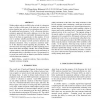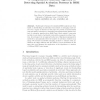93 search results - page 2 / 19 » Support Vector Clustering for Brain Activation Detection |
ICPR
2010
IEEE
14 years 7 days ago
2010
IEEE
We present a method that automatically detects chewing events in surveillance video of a subject. Firstly, an Active Appearance Model (AAM) is used to track a subject’s face acr...
VLDB
2007
ACM
14 years 5 months ago
2007
ACM
Whenever an intrusion occurs, the security and value of a computer system is compromised. Network-based attacks make it difficult for legitimate users to access various network ser...
IJCNN
2007
IEEE
13 years 11 months ago
2007
IEEE
Abstract—Putative brain processes responsible for understanding language are based on spreading activation in semantic networks, providing enhanced representations that involve c...
ISBI
2008
IEEE
14 years 6 months ago
2008
IEEE
Within-subject analysis in fMRI relies on both (i) a detection step to localize which parts of the brain are activated by a given stimulus type, and on (ii) an estimation step to ...
MICCAI
2006
Springer
14 years 6 months ago
2006
Springer
Traditional techniques for statistical fMRI analysis are often based on thresholding of individual voxel values or averaging voxel values over a region of interest. In this paper w...


